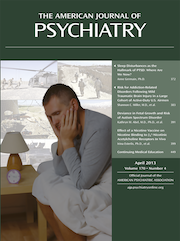Defining Psychiatric Disease
To the Editor: In his review of Horwitz and Wakefield’s book on anxiety in the January issue of the Journal (1), Dr. Kenneth Kendler rightly points out two major problems with definitions of disorder or disease based on putative “dysfunction of an evolved mind/brain mechanism,” namely, 1) it is almost impossible to confirm or refute claims about such evolved mechanisms through any empirical studies, and 2) the “evolved mechanisms” concept cannot be applied coherently to individual genomes, which may differ markedly in their sensitivity to environmental stimuli. But Dr. Kendler may be too willing to yield to the “harmful dysfunction” model advocated by Horwitz and Wakefield (“I cannot suggest a much better approach…”).
Historically, the concept of human “disease” (etymologically, dis-ease) arose in response to various instances of prolonged or intense suffering and incapacity not due to an obvious wound or a deliberate attack (2). Thus, disease is not a biological or even etiological term, but rather a term of ordinary language (3), often first applied to the suffering and incapacitated person by family or friends. Only subsequent to the recognition of disease does our system of classification become relevant, insofar as it aims to identify the type of disease at hand. Applied to anxiety, a patient has psychiatric disease or disorder when his or her anxiety is such that it causes prolonged or intense suffering and incapacity—which we may define by whatever measures we care to specify. We need not invoke unverifiable evolutionary mechanisms at all (4).
1 : All We Have to Fear: Psychiatry’s Transformation of Natural Anxieties Into Mental Disorders (book review). Am J Psychiatry 2013; 170:124–125Link, Google Scholar
2 : What is disease? Philos Sci 1954; 21:193–203Crossref, Google Scholar
3 : The Blue and Brown Books. New York, Harper & Row, 1958Google Scholar
4 : On myths and countermyths: more on Szaszian fallacies. Arch Gen Psychiatry 1979; 36:139–144Crossref, Medline, Google Scholar



